Conflict over Mining in Rural China: A Comprehensive Survey of Intentions and Strategies for Environmental Activism
Abstract
:1. Introduction
2. A Review of Environmental Activism
3. Materials and Methods
3.1. Analytical Framework
3.2. Study Sites
3.3. Characteristics of the Sample
4. Results
4.1. Descriptive Statistics of the Predicting Variables
4.2. Resident’s Environmental Activism
4.3. Variances of Environmental Activism by the Control Variables
4.4. Result of the Path Analysis
5. Conclusions
Author Contributions
Acknowledgements
Conflicts of Interest
Appendix A
| Variable | Description of the Item | Choices |
|---|---|---|
| EA | Have you ever taken any actions listed below against the polluting mines? | |
| EA1 | Report to the village committee? (xiang cunweihui fanying qingkuang?) | Yes: 1; No: 0 |
| EA2 | Report to the local township government? (xiang dangdi zhengfu fanying qingkuang) | Yes: 1; No: 0 |
| EA3 | Approach environmental protection bureaus (EPBs) by letter or phone? (xie xin huozhe da dianhua xiang huanbao bumeng tousu?) | Yes: 1; No: 0 |
| EA4 | Approach environmental protection bureaus (EPBs) by visit? (qinzi dao huanbao bumeng shangfang tousu, qingqiu chuli) | Yes: 1; No: 0 |
| EA5 | Directly negotiate with the polluting mines? (zhijie he wuran qiye jiaoshe, xunqiu buchang?) | Yes: 1; No: 0 |
| EA6 | Resort to the media? (xiang meiti baoguang?) | Yes: 1; No: 0 |
| EA7 | Resort to the judicial system? (dui wuran qiye tichu falv susong, qingqiu sunhai peichang?) | Yes: 1; No: 0 |
| EA8 | Participate in a protest against the polluting mines? (canyu duo wuran qiye de kangyi huodong?) | Yes: 1; No: 0 |
| EA9 | Abstain from applying for a job in the polluting mines? (buqu wuran qiye yingping he gongzuo?) | Yes: 1; No: 0 |
| SERIOUSNESS | To what extent is the environmental pollution in your community serious? (zai ni de juzhuqu huanjing wuran zongtishang shi) | 1: none; 2: slight; 3: medium; 4: serious; 5: very serious; |
| HEALTH | Are you concerned that environmental pollution brings harm to your life and health? (ni shifou danxin huanjing wuran gei ni de shenghuo he jiankang dailai yingxiang?) | 1: not at all; 2: slight; 3: medium; 4: concerned; 5: very concerned |
| NEIGHBOR | To what extent do you think that the neighbors have participated in the actions against the polluting mines? (ni renwei zhouwei de linju zai hezhong chengdu shang canyu le zhendui wuran qiye de xingdong?) | 1 = Lowest; 5 = highest |
| APPRECIATION | To what extent do you think your environmental activism will be acknowledged and appreciated by society? (ni renwei ni de huanbao xingdong zai hezhong chengdu shang neng dedao shehui de renke he zansong?) | |
| EFFECTIVENESS | To what extent do you think the environmental activism could improve the environmental quality? (ni renwei huanjing xingdong zai hezhong chengdu shang neng gaishan huanjing de zhiliang?) | |
| SUPPORT | To what extent do you think the environmental protection bureaus deal with environmental complaints actively and effectively? (ni renwei huanbao bumen zai hezhong chengdu shang neng jiji he youxiao de chuli huanbao tousu?) | |
| INTENTION | In order to improve environmental quality, to what degree are you willing to take actions against polluting mines? (ni shifou yuanyi weile gaishan huanjing er dui fujin de wuran qiye caiqu xiangying de xingdong?) |
References
- MEP. 2015 Report on the State of Environment in China; Ministry of Environmental Protection: Beijing, China, 2016.
- Kan, H. Environment and health in china: challenges and opportunities. Environ. Health Perspect. 2009, 117, A530–A531. [Google Scholar] [CrossRef] [PubMed]
- Chen, B.; Hong, C.; Kan, H. Exposures and health outcomes from outdoor air pollutants in China. Toxicology 2004, 198, 291–300. [Google Scholar] [CrossRef] [PubMed]
- Ho, P. Greening without conflict? Environmentalism, NGOs and civil society in China. Dev. Chang. 2001, 32, 893–921. [Google Scholar] [CrossRef]
- Saich, T. Negotiating the state: The development of social organizations in China. China Q. 2000, 161, 124–141. [Google Scholar] [CrossRef]
- Yang, G. Environmental NGOs and institutional dynamics in China. China Q. 2005, 181, 46–66. [Google Scholar] [CrossRef]
- Huang, Y. Tackling China’s Environmental Health Crisis. Available online: http://www.cfr.org/china/tackling-chinas-environmental-health-crisis/p36538 (accessed on 14 October 2016).
- Lang, G.; Xu, Y. Anti-incinerator campaigns and the evolution of protest politics in China. Environ. Polit. 2013, 22, 832–848. [Google Scholar] [CrossRef]
- Huang, R.; Yip, N.-M. Internet and activism in urban China: A case study of protests in Xiamen and Panyu. J. Comp. Asian Dev. 2012, 11, 201–223. [Google Scholar] [CrossRef]
- Li, W.; Liu, J.; Li, D. Getting their voices heard: Three cases of public participation in environmental protection in China. J. Environ. Manag. 2012, 98, 65–72. [Google Scholar] [CrossRef] [PubMed]
- Johnson, T. The health factor in anti-waste incinerator campaigns in Beijing and Guangzhou. China Q. 2013, 214, 356–375. [Google Scholar] [CrossRef]
- Van Rooij, B. The people vs. pollution: understanding citizen action against pollution in China. J. Contemp. China 2010, 19, 55–77. [Google Scholar] [CrossRef]
- Jing, J. Environmental protests in rural China. In China Society, Change. Conflict and Resistance, 2nd ed.; RoutledgeCurzon: Oxford, UK, 2003; pp. 143–160. [Google Scholar]
- Ho, P.; Edmonds, R.L. China’s Embedded Activism: Limitations and Constraints of a Social Movement; Routledge: London, UK, 2008. [Google Scholar]
- Mol, A.P.; Carter, N.T. China’s environmental governance in transition. Environ. Politics 2006, 15, 149–170. [Google Scholar] [CrossRef]
- Xie, L. Environmental Activism in China; Routledge: London, UK, 2009; Volume 9. [Google Scholar]
- Lora-Wainwright, A. An anthropology of ‘cancer villages’: Villagers’ perspectives and the politics of responsibility. J. Contemp. China 2010, 19, 79–99. [Google Scholar] [CrossRef]
- Wheeler, D.; Dasgupta, S. Citizen Complaints as Environmental Indicators: Evidence from CHINA. 1997. Available online: http://documents.worldbank.org/curated/en/450781468746709957/Citizen-complaints-as-environmental-indicators-evidence-from-China (accessed on 20 April 2016).
- Warwick, M.; Ortolano, L. Benefits and costs of Shanghai’s environmental citizen complaints system. China Inf. 2007, 21, 237–268. [Google Scholar] [CrossRef]
- Stern, R.E. From dispute to decision: Suing polluters in China. China Q. 2011, 206, 294–312. [Google Scholar] [CrossRef]
- Moser, A.J.; Yang, T. Environmental Tort Litigation in China. 2011. Available online: https://papers.ssrn.com/sol3/papers.cfm?abstract_id=1821748 (accessed on 1 July 2016).
- Wang, C. Chinese environmental law enforcement: current deficiencies and suggested reforms. Vt. J. Environ. Law 2006, 8, 159. [Google Scholar]
- Cai, Y. Local governments and the suppression of popular resistance in China. China Q. 2008, 193, 24–42. [Google Scholar] [CrossRef]
- Ajzen, I.; Fishbein, M. Attitude-behavior relations: A theoretical analysis and review of empirical research. Psychol. Bull. 1977, 84, 888. [Google Scholar] [CrossRef]
- Ajzen, I. The theory of planned behavior. Org. Behav. Hum. Decis. Process. 1991, 50, 179–211. [Google Scholar] [CrossRef]
- Rui, H. Development, transition and globalization in China’s coal industry. Dev. Chang. 2005, 36, 691–710. [Google Scholar] [CrossRef]
- Shen, L.; Gunson, A.J. The role of artisanal and small-scale mining in China’s economy. J. Clean. Prod. 2006, 14, 427–435. [Google Scholar] [CrossRef]
- Lei, Y.; Cui, N.; Pan, D. Economic and social effects analysis of mineral development in China and policy implications. Res. Policy 2013, 38, 448–457. [Google Scholar] [CrossRef]
- Ge, J.; Lei, Y. Mining development, income growth and poverty alleviation: A multiplier decomposition technique applied to China. Res. Policy 2013, 38, 278–287. [Google Scholar] [CrossRef]
- Perreault, T. Dispossession by accumulation? Mining, water and the nature of enclosure on the Bolivian Altiplano. Antipode 2013, 45, 1050–1069. [Google Scholar] [CrossRef]
- Lu, J.; Lora-Wainwright, A. Historicizing sustainable livelihoods: A pathways approach to lead mining in rural central China. World Dev. 2014, 62, 189–200. [Google Scholar] [CrossRef]
- Zhang, J.; Rao, Y.; Geng, Y.; Fu, M.; Prishchepov, A.V. A novel understanding of land use characteristics caused by mining activities: A case study of Wu’an, China. Ecol. Eng. 2017, 99, 54–69. [Google Scholar] [CrossRef]
- Cao, Y.; Bai, Z.; Sun, Q.; Zhou, W. Rural settlement changes in compound land use areas: Characteristics and reasons of changes in a mixed mining-rural-settlement area in Shanxi Province, China. Habitat Int. 2017, 61, 9–21. [Google Scholar] [CrossRef]
- Li, Q.; Stoeckl, N.; King, D.; Gyuris, E. Exploring the impacts of coal mining on host communities in Shanxi, China—Using subjective data. Res. Policy 2017, 53, 125–134. [Google Scholar] [CrossRef]
- Yang, X.; Zhao, H.; Ho, P. Mining-induced displacement and resettlement in China: A study covering 27 villages in 6 provinces. Res. Policy 2017, 53, 408–418. [Google Scholar] [CrossRef]
- Wu, F. Environmental activism in provincial China. J. Environ. Policy Plan. 2013, 15, 89–108. [Google Scholar] [CrossRef]
- Hofrichter, J.; Reif, K. Evolution of environmental attitudes in the European Community. Scand. Polit. Stud. 1990, 13, 119–146. [Google Scholar]
- Yang, G.; Calhoun, C. Media, civil society, and the rise of a green public sphere in China. China Inf. 2007, 21, 211–236. [Google Scholar] [CrossRef]
- Cooper, C.M. ‘This is Our Way In’: The Civil Society of Environmental NGOs in South-West China 1. Gov. Oppos. 2006, 41, 109–136. [Google Scholar] [CrossRef]
- Hildebrandt, T. The political economy of social organization registration in China. China Q. 2011, 208, 970–989. [Google Scholar] [CrossRef]
- Ho, P.; Vermeer, E.B. China’s Limits to Growth: Greening State and Society; Blackwell: Oxford, UK, 2006. [Google Scholar]
- Chen, J. Transnational environmental movement: Impacts on the green civil society in China. J. Contemp. China 2010, 19, 503–523. [Google Scholar] [CrossRef]
- Morton, K. The emergence of NGOs in China and their transnational linkages: implications for domestic reform. Aust. J. Int. Aff. 2005, 59, 519–532. [Google Scholar] [CrossRef]
- Lora-Wainwright, A.; Zhang, Y.; Wu, Y.; Van Rooij, B. Learning to live with pollution: The making of environmental subjects in a Chinese industrialized village. China J. 2012, 68, 106–124. [Google Scholar] [CrossRef]
- Lora-Wainwright, A. The inadequate life: Rural industrial pollution and lay epidemiology in China. China Q. 2013, 214, 302–320. [Google Scholar] [CrossRef]
- Van Rooij, B.; Wainwright, A. L.; Wu, Y.; Zhang, Y. The Compensation Trap: The Limits of Community-Based Pollution Regulation in China. Pace Environ. Law Rev. 2012, 29. Available online: https://digitalcommons.pace.edu/pelr/vol29/iss3/2/ (accessed on 1 July 2017).
- Harwit, E. Spreading telecommunications to developing areas in China: Telephones, the Internet and the digital divide. China Q. 2004, 180, 1010–1030. [Google Scholar] [CrossRef]
- Huang, R.; Sun, X. Weibo network, information diffusion and implications for collective action in China. Inf. Commun. Soc. 2014, 17, 86–104. [Google Scholar] [CrossRef]
- Deng, Y.; Yang, G. Pollution and protest in China: Environmental mobilization in context. China Q. 2013, 214, 321–336. [Google Scholar] [CrossRef]
- Tilt, B. The politics of industrial pollution in rural China. J. Peasant Stud. 2013, 40, 1147–1164. [Google Scholar] [CrossRef]
- Ma, T. Environmental mass incidents in rural China: Examining large-scale unrest in Dongyang, Zhejiang. China Environ. Ser. 2008, 33. Available online: https://pdf.usaid.gov/pdf_docs/pnady986.pdf#page=43 (accessed on 1 July 2017).
- Lora-Wainwright, A. Of farming chemicals and cancer deaths: The politics of health in contemporary rural China. Soc. Anthropol. 2009, 17, 56–73. [Google Scholar] [CrossRef]
- McMullin, J. Do Chinese Environmental Laws Work-A Study of Litigation as a Response to the Problem of Fishery Pollution in China. UCLA Pac. Basin Law J. 2008, 26, 142. [Google Scholar]
- Stern, R.E. On the frontlines: making decisions in Chinese civil environmental lawsuits. Law Policy 2010, 32, 79–103. [Google Scholar] [CrossRef]
- He, X. Court finance and court responses to judicial reforms: A tale of two Chinese courts. Law Policy 2009, 31, 463–486. [Google Scholar] [CrossRef]
- Fu, H. Putting China’s Judiciary into Perspective: Is It Independent, Competent, and Fair? Beyond Common. Knowl. Emp. Approaches Rule Law 2003, 193–219. Available online: http://hub.hku.hk/handle/10722/119216 (accessed on 1 July 2017).
- Zeng, M.; Zhan, J.V. Sharing resource wealth for peace: A Chinese strategy to cope with the resource curse. Extr. Ind. Soc. 2015, 2, 302–309. [Google Scholar] [CrossRef]
- Conde, M. Resistance to mining. A review. Ecol. Econ. 2017, 132, 80–90. [Google Scholar] [CrossRef]
- Walter, M.; Martinez-Alier, J. How to be heard when nobody wants to listen: Community action against mining in Argentina. Can. J. Dev. Stud. 2010, 30, 281–301. [Google Scholar]
- Pigrau, A.; Borràs, S.; i Manzano, J.J.; Cardesa-Salzmann, A. Legal Avenues for EJOs to Claim Environmental Liability; EJOLT Report: 2012. Available online: http://www.ejolt.org/wordpress/wp-content/uploads/2012/08/120731_EJOLT-4-High.pdf (accessed on 8 May 2018).
- Paredes, M. The glocalization of mining conflict: Cases from Peru. Extr. Ind. Soc. 2016, 3, 1046–1057. [Google Scholar] [CrossRef]
- Urkidi, L. A glocal environmental movement against gold mining: Pascua–Lama in Chile. Ecol. Econ. 2010, 70, 219–227. [Google Scholar] [CrossRef]
- Brown, B.; Spiegel, S.J. Resisting coal: Hydrocarbon politics and assemblages of protest in the UK and Indonesia. Geoforum 2017, 85, 101–111. [Google Scholar] [CrossRef]
- Ho, P. Embedded activism and political change in a semiauthoritarian context. China Inf. 2007, 21, 187–209. [Google Scholar] [CrossRef]
- Feng, S. The Silent Majority: Chaxu Geju and Environmental Action in Urban China. J. Renmin Univ. China 2007, 1, 021. [Google Scholar]
- Munro, N. Profiling the victims: Public awareness of pollution-related harm in China. J. Contemp. China 2014, 23, 314–329. [Google Scholar] [CrossRef]
- Liu, X.; Wang, C.; Shishime, T.; Fujitsuka, T. Environmental activisms of firm’s neighboring residents: An empirical study in China. J. Clean. Prod. 2010, 18, 1001–1008. [Google Scholar] [CrossRef]
- Cai, Y. Social conflicts and modes of action in China. China J. 2008, 59, 89–109. [Google Scholar] [CrossRef]
- Michelson, E. Climbing the dispute pagoda: Grievances and appeals to the official justice system in rural China. Am. Sociol. Rev. 2007, 72, 459–485. [Google Scholar] [CrossRef]
- Fishbein, M.; Ajzen, I. Belief, Attitude, Intention and Behavior: An Introduction to Theory and Research; Addison-Wesley: Reading, MA, USA, 1975. [Google Scholar]
- Séguin, C.; Pelletier, L.G.; Hunsley, J. Toward a model of environmental activism. Environ. Behav. 1998, 30, 628–652. [Google Scholar] [CrossRef]
- Lubell, M. Environmental activism as collective action. Environ. Behav. 2002, 34, 431–454. [Google Scholar] [CrossRef]
- Fox-Cardamone, L.; Hinkle, S.; Hogue, M. The correlates of antinuclear activism: Attitudes, subjective norms, and efficacy. J. Appl. Soc. Psychol. 2000, 30, 484–498. [Google Scholar] [CrossRef]
- Kelly, C.; Breinlinger, S. Attitudes, intentions, and behavior: A study of women’s participation in collective action. J. Appl. Soc. Psychol. 1995, 25, 1430–1445. [Google Scholar] [CrossRef]
- Tindall, D.B.; Davies, S.; Mauboules, C. Activism and conservation behavior in an environmental movement: The contradictory effects of gender. Soc. Nat. Res. 2003, 16, 909–932. [Google Scholar] [CrossRef]
- Fielding, K.S.; McDonald, R.; Louis, W.R. Theory of planned behaviour, identity and intentions to engage in environmental activism. J. Environ. Psychol. 2008, 28, 318–326. [Google Scholar] [CrossRef]
- Liu, W.; Wang, C.; Mol, A.P. Rural public acceptance of renewable energy deployment: The case of Shandong in China. Appl. Energy 2013, 102, 1187–1196. [Google Scholar] [CrossRef]
- Bang, H.K.; Ellinger, A.E.; Hadjimarcou, J.; Traichal, P.A. Consumer concern, knowledge, belief, and attitude toward renewable energy: An application of the reasoned action theory. Psychol. Mark. 2000, 17, 449–468. [Google Scholar] [CrossRef]
- Park, N.; Yang, A. Online environmental community members’ intention to participate in environmental activities: An application of the theory of planned behavior in the Chinese context. Comput. Hum. Behav. 2012, 28, 1298–1306. [Google Scholar] [CrossRef]
- Orbell, S.; Sheeran, P. ‘Inclined abstainers’: A problem for predicting health-related behaviour. Br. J. Soc. Psychol. 1998, 37, 151–165. [Google Scholar] [CrossRef] [PubMed]
- Mohai, P. Public concern and elite involvement in environmental-conservation issues. Soc. Sci. Q. 1985, 66, 820. [Google Scholar]
- Finkel, S.E.; Muller, E.N.; Opp, K.-D. Personal influence, collective rationality, and mass political action. Am. Political Sci. Rev. 1989, 83, 885–903. [Google Scholar] [CrossRef]
- State Council, Guowuyuan Guanyu Yinfa Quanguo Ziyuanxing Chengshi Kechixu Fazhan Guihua [Notice of the State Council on Issuing the Sustainable Development Plan of Resource-Dependent Cities Nationwide (2013–2020)]; State Council: Beijing, China, 2013. Available online: http://www.gov.cn/zwgk/2013-12/03/content_2540070.htm (accessed on 6 September 2014).
- Small, M.L. How many cases do I need? On science and the logic of case selection in field-based research. Ethnography 2009, 10, 5–38. [Google Scholar] [CrossRef]
- Morse, J.M. Theoretical Saturation. In Encyclopedia of Social Science Research Methods; Lewis-Beck, M.S., Bryman, A., Liao, T.F., Eds.; SAGE Publications: Thousand Oaks, CA, USA, 2004. [Google Scholar]
- O’brien, R.M. A caution regarding rules of thumb for variance inflation factors. QualQuant. 2007, 41, 673–690. [Google Scholar] [CrossRef]
- Hofstede, G. Culture’s Consequences: Comparing Values, Behaviors, Institutions and Organizations across Nations; Sage Publications: Thousand Oaks, CA, USA, 2003. [Google Scholar]
- Dong, Y.; Ishikawa, M.; Liu, X.; Hamori, S. The determinants of citizen complaints on environmental pollution: An empirical study from China. J. Clean. Prod. 2011, 19, 1306–1314. [Google Scholar] [CrossRef]
- He, G.; Zhang, L.; Mol, A.P.; Wang, T.; Lu, Y. Why small and medium chemical companies continue to pose severe environmental risks in rural China. Environ. Pollut. 2014, 185, 158–167. [Google Scholar] [CrossRef] [PubMed]
- Minzner, C.F. Xinfang: An alternative to formal Chinese legal institutions. Stanf. J. Int. Law 2006, 42, 103. [Google Scholar]
- Ho, P. Unmaking China’s Development: Function and Credibility of Institutions; Cambridge University Press: Cambridge, UK, 2017. [Google Scholar]
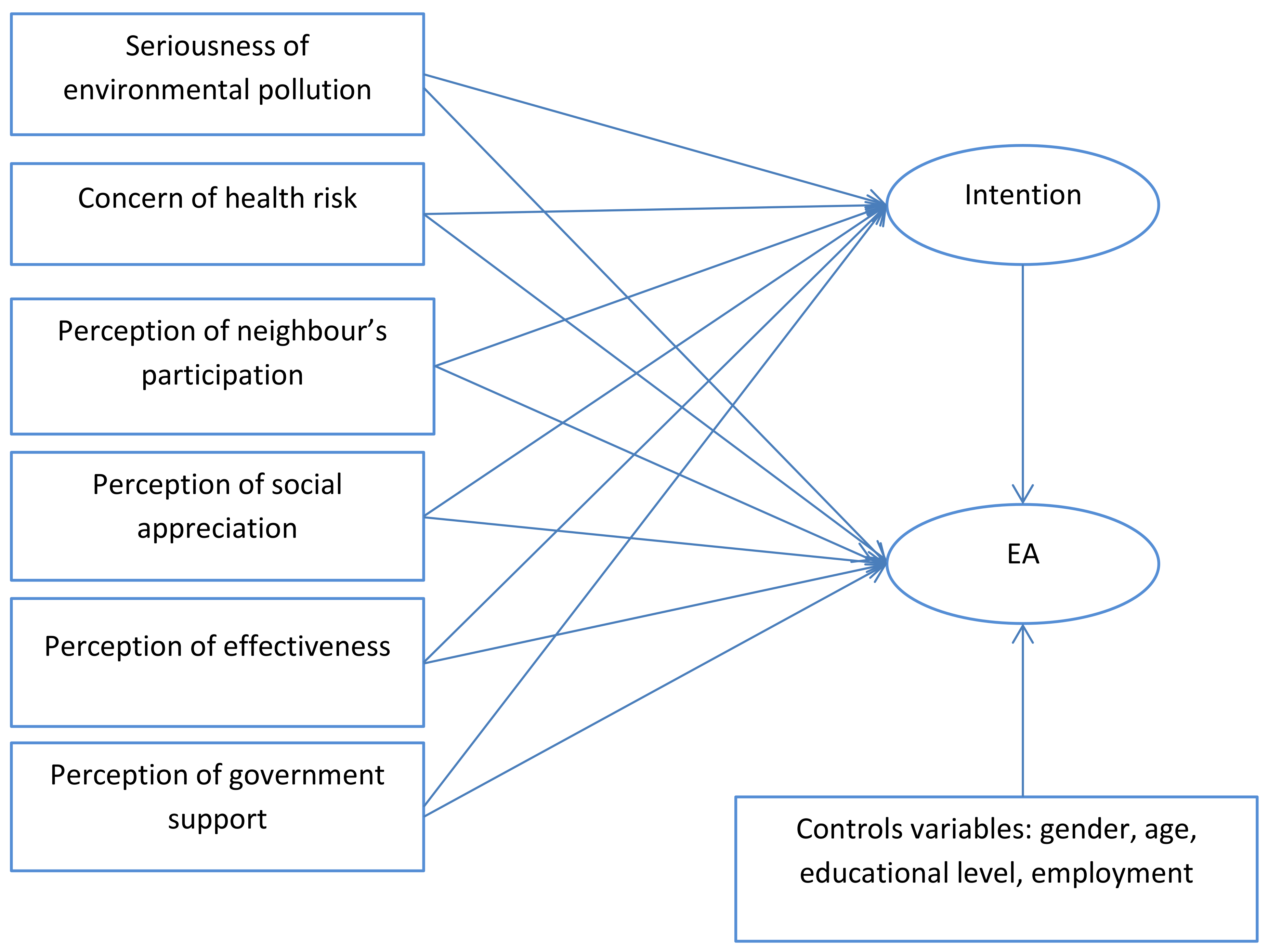
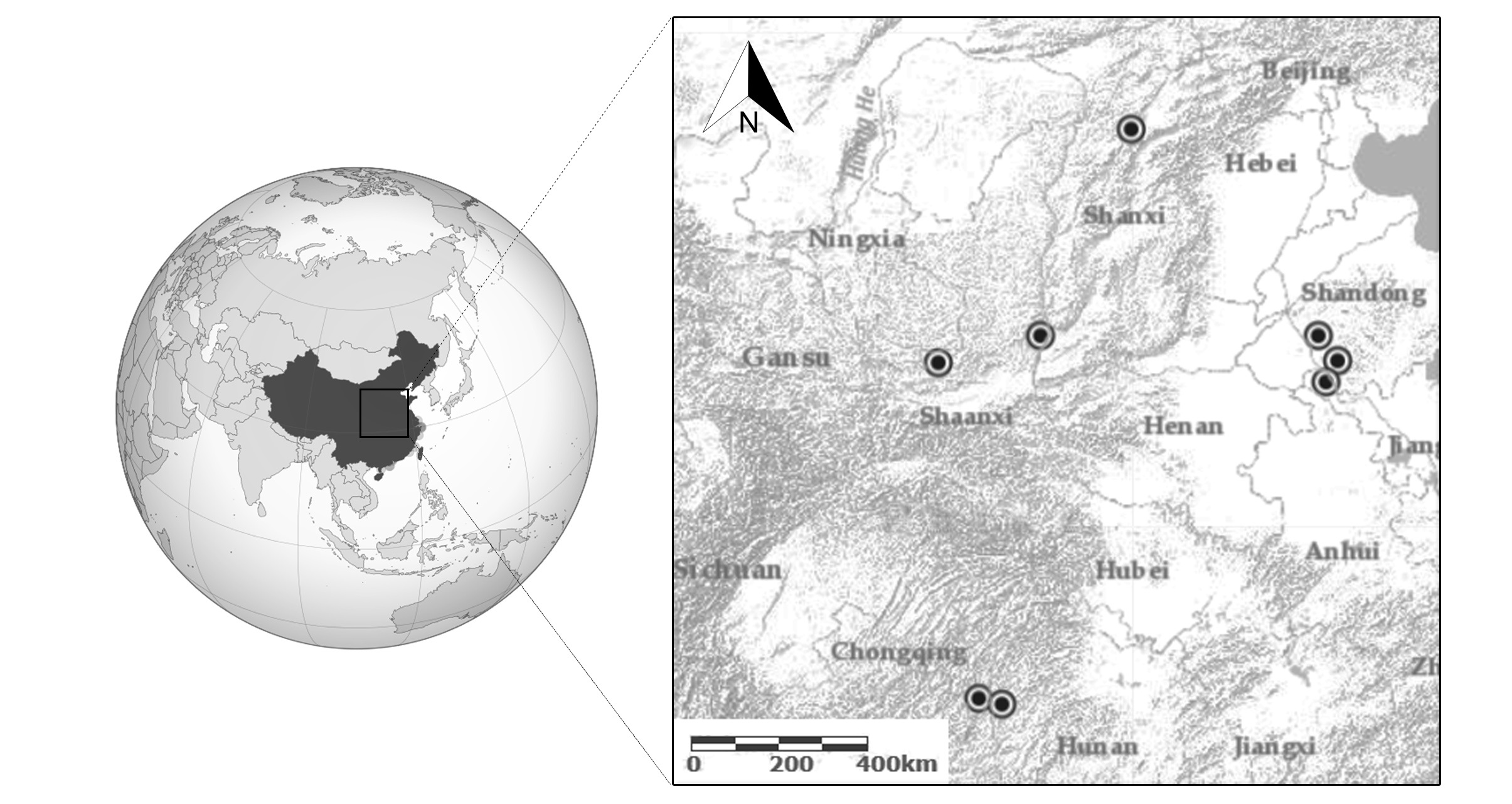
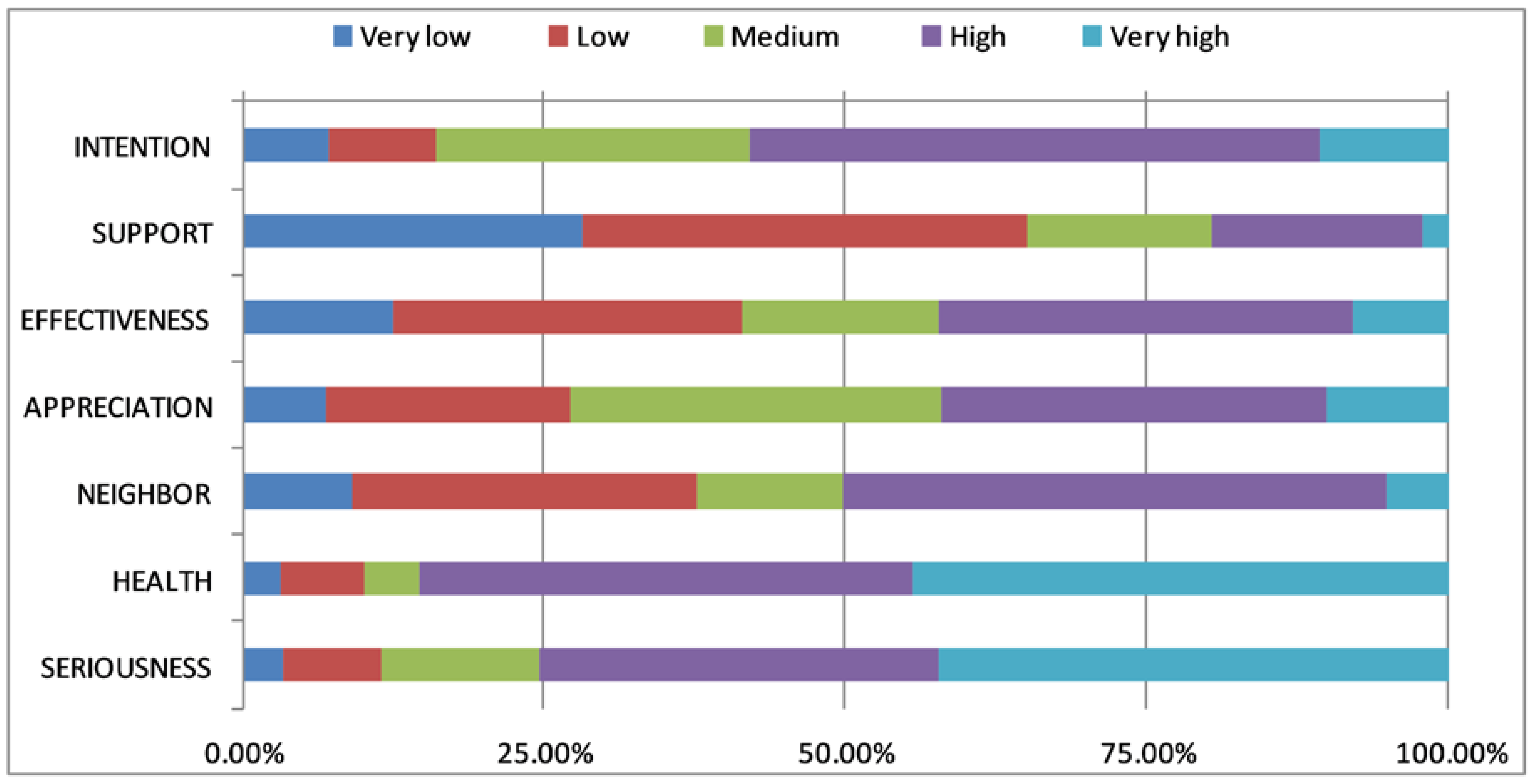
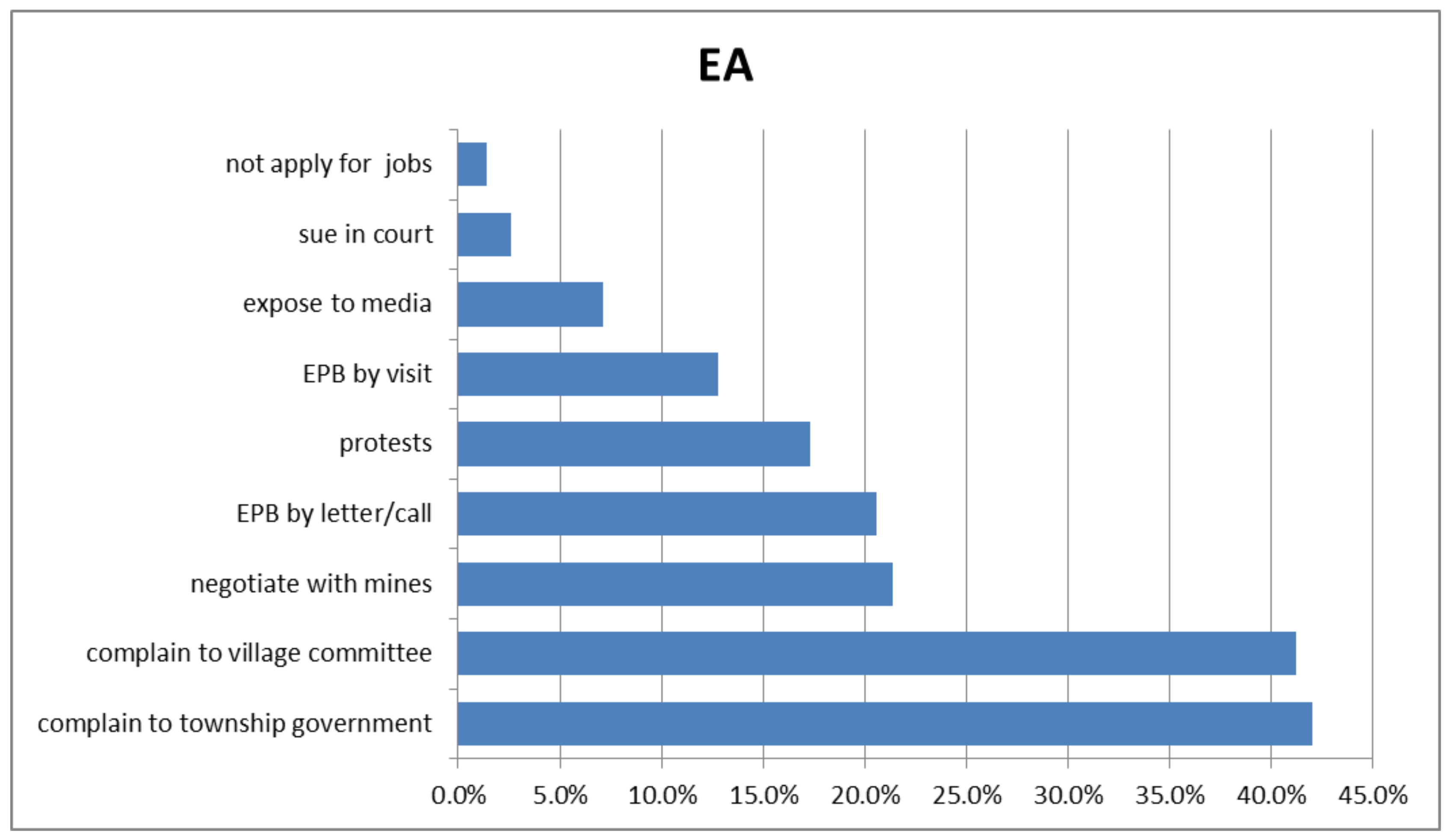
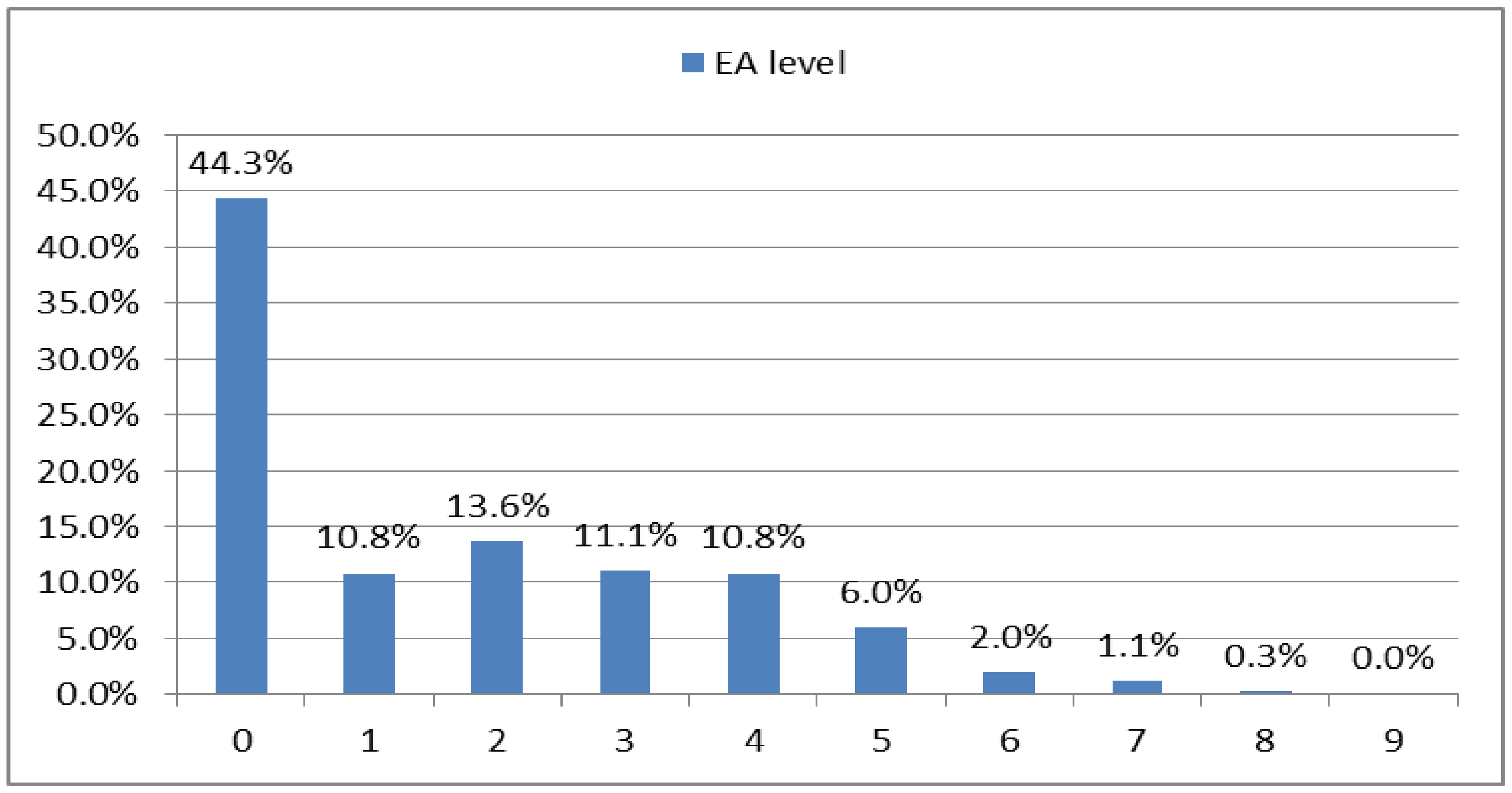
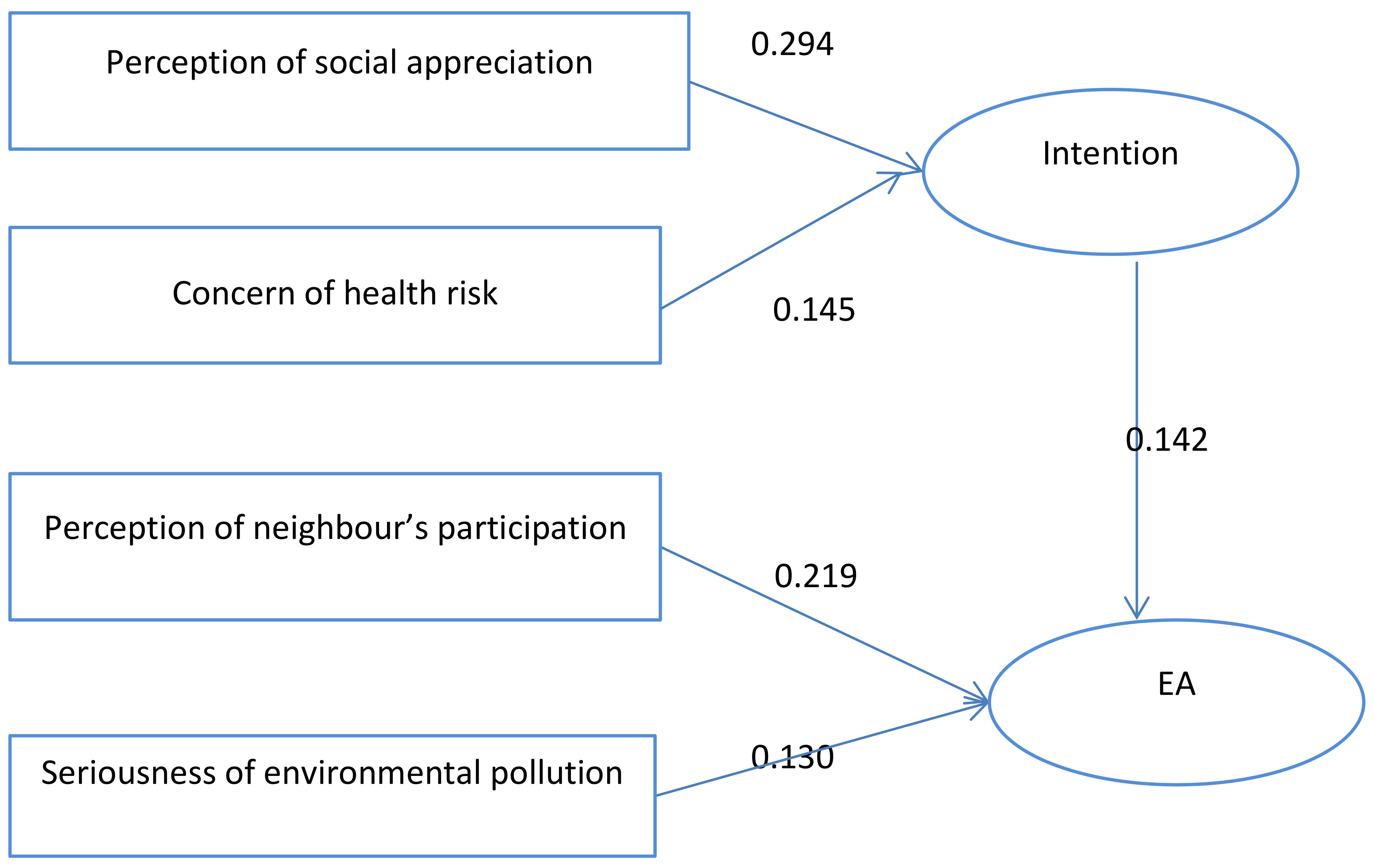
| Variable | Description of the iTem | Valuation |
|---|---|---|
| Environmental activism level | Sum of (EA1–EA9) | 0–9 |
| SERIOUSNESS | Perception of severity of pollution | 1 = Lowest; 5 = highest |
| HEALTH | Perception of health risks of pollution | |
| NEIGHBOR | Perception of neighbors’ participation in EA | |
| APPRECIATION | Social appreciation of EA | |
| EFFECTIVENESS | Effectiveness of EA efforts | |
| SUPPORT | Degree of government support to EA | |
| INTENTION | Willingness of EA against polluters |
| Characteristics | Group | Number | Percentage (%) |
|---|---|---|---|
| Gender | Male | 239 | 67.9 |
| Female | 113 | 32.1 | |
| Age | 18–30 | 38 | 10.8 |
| 31–60 | 194 | 55.1 | |
| >61 | 120 | 34.0 | |
| Education | Illiterate | 69 | 19.6 |
| Primary school | 99 | 28.1 | |
| Middle school | 125 | 35.6 | |
| High school and above | 61 | 16.7 | |
| Household size | ≤3 | 104 | 29.5 |
| 4–5 | 123 | 34.9 | |
| ≥6 | 125 | 35.6 | |
| Mean | 4.92 | ||
| Employment in Mines | Employed in mines | 121 | 34.4 |
| Not employed in mines | 231 | 65.6 |
| Control Variables | EA Mean | Significance (t-Test/ANOVA) | Finding | |
|---|---|---|---|---|
| Gender | Male | 1.88 | t = 3.613; p = 0.000 | Significant |
| Female | 1.12 | |||
| Age | <30 | 1.63 | F = 0.180; p = 0.835 | Not significant |
| 30–60 | 1.59 | |||
| >60 | 1.719 | |||
| Education level | Illiterate | 1.67 | F = 0.093; p = 0.964 | Not significant |
| Primary school | 1.66 | |||
| Middle school | 1.57 | |||
| High school and above | 1.71 | |||
| Employment | Employed in mines | 1.36 | F = 2.101; p = 0.037 | Significant |
| Not employed in mines | 1.78 | |||
| Dependent Variable | Predictors | Unstandardized Coefficients | Standardized Coefficients | t | Significance | |
|---|---|---|---|---|---|---|
| B | Std. Error | Beta | ||||
| INTENTION (n = 352; R2 = 0.196, F = 20.764, p < 0.01) | Constant | 1.722 | 0.286 | 6.026 | 0.000 | |
| APPRECIATION | 0.270 | 0.067 | 0.294 | 4.053 | 0.000 | |
| HEALTH | 0.147 | 0.058 | 0.145 | 2.553 | 0.011 | |
| EA Level (n = 352; R2 = 0.102, F = 8.504, p < 0.01) | Constant | −1.338 | 0.688 | −1.944 | 0.053 | |
| NEIGHBOR | 0.367 | 0.105 | 0.219 | 3.484 | 0.001 | |
| INTENT | 0.276 | 0.120 | 0.142 | 2.299 | 0.022 | |
| SERIOUSNESS | 0.241 | 0.113 | 0.130 | 2.1132 | 0.034 | |
© 2018 by the authors. Licensee MDPI, Basel, Switzerland. This article is an open access article distributed under the terms and conditions of the Creative Commons Attribution (CC BY) license (http://creativecommons.org/licenses/by/4.0/).
Share and Cite
Yang, X.; Ho, P. Conflict over Mining in Rural China: A Comprehensive Survey of Intentions and Strategies for Environmental Activism. Sustainability 2018, 10, 1669. https://0-doi-org.brum.beds.ac.uk/10.3390/su10051669
Yang X, Ho P. Conflict over Mining in Rural China: A Comprehensive Survey of Intentions and Strategies for Environmental Activism. Sustainability. 2018; 10(5):1669. https://0-doi-org.brum.beds.ac.uk/10.3390/su10051669
Chicago/Turabian StyleYang, Xiuyun, and Peter Ho. 2018. "Conflict over Mining in Rural China: A Comprehensive Survey of Intentions and Strategies for Environmental Activism" Sustainability 10, no. 5: 1669. https://0-doi-org.brum.beds.ac.uk/10.3390/su10051669




